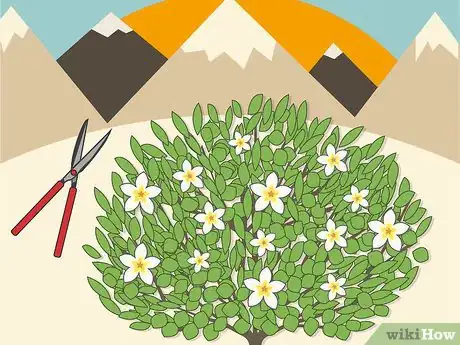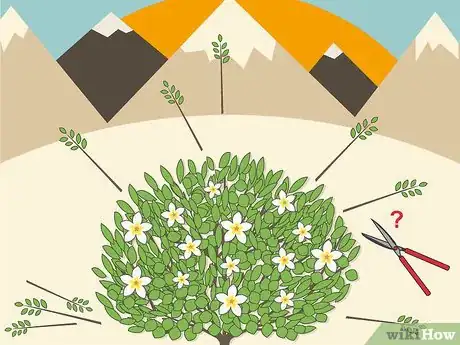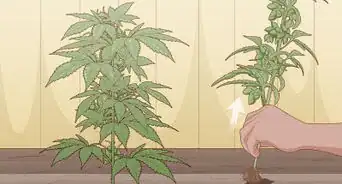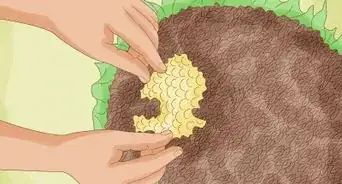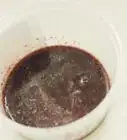This article was co-authored by Andrew Carberry, MPH. Andrew Carberry is a Food Systems Expert and the Senior Program Associate at the Wallace Centere at Winrock International in Little Rock, Arkansas. He has worked in food systems since 2008 and has experience working on farm-to-school projects, food safety programs, and working with local and state coalitions in Arkansas. He is a graduate of the College of William and Mary and holds a Masters degree in public health and nutrition from the University of Tennessee.
wikiHow marks an article as reader-approved once it receives enough positive feedback. This article received 32 testimonials and 100% of readers who voted found it helpful, earning it our reader-approved status.
This article has been viewed 746,212 times.
Hibiscus are lovely plants with beautiful flowers, but after a few seasons of growing, your hibiscus may not be producing so many of those eye-catching buds anymore. Rather than let your hibiscus flounder, learn the basics of pruning to encourage new growth. To prune hibiscus, make major cuts in early spring and minor cuts throughout the spring and summer, cutting out branches facing outward and above a node; the exact pruning style, however, may vary based on the needs of your plant. With a bit of corrective cutting, your garden will be full of healthy new hibiscus buds.
Steps
Understanding Pruning
-
1Know why you prune. Hibiscus plants grow with terminal flowers; this means that each flower on a hibiscus plant grows at the end of a branch. Pruning a healthy hibiscus bush will encourage growth and tell the plant to grow more branches, thus producing more flowers. You can also prune a damaged or dying tree to prevent future decay and to promote new, healthy growth.
-
2Learn when to prune. Pruning must be timed to line up with the natural growth patterns of the hibiscus plant. You should never prune hibiscus in the late fall or winter, as this will prevent new growth in the Spring. Exact times will vary depending on your location, but generally full/major prunes should be done in the early spring, with minor pruning done up till the beginning of fall around September.[1]
- If you keep your hibiscus plants inside during the winter, wait until you move them outside to prune.
Advertisement -
3Sterilize your pruning tools. To do damage-free pruning, you'll need to get a very sharp knife, a pair of sharp gardening shears, a pair of sharp lopping shears, and a hand saw for anything too big to be cut with your smaller tools. Sterilize all tools before starting and between pruning each plant, to prevent the spread of disease. You can sterilize with rubbing alcohol, hand sterilizer, or horticultural disinfectant.
- Your tools must absolutely be sharp; a dull knife, shears, or saw will cause more harm than good if you try to prune with them. Take the time to sharpen your tools, or buy new ones if yours are too old.[2]
-
4Know where to prune. Keeping in mind that the location you prune is the location of new growth, you always want to prune your hibiscus on branches facing outwards. You'll make all cuts ¼-inch from the top of a node (the location of a leaf/twig) at an upwards 45-degree angle. The lower end of each cut should be near the center of the bush, while the higher end of the cut should be nearer to the outside of the bush. This helps water run off the cut surface instead of pooling, which reduces the risk of infection.
-
5Know how much to remove. Although the amount of the plant that you prune will vary from situation to situation, the general rule is that you should never cut more than ⅔ of any one branch off. Cutting off too much of the plant is no longer considered pruning, but simply damaging the hibiscus.
Types of Pruning
-
1Consider a 'pinch' prune. There are several approaches you can use to prune hibiscus. One light approach is to "pinch" the plant by cutting off just the ends of the branches near the top, so as to stimulate a bit of growth without losing the bulk of the plant. This is the mildest form of pruning and is the safest for beginners to accomplish. Pinching should be done primarily on young or small plants, as they don't need much pruning early in their life to promote lots of new growth. Cut the tips of each branch off at the top-most node or higher.
-
2Try selective pruning. This is the next step up from 'pinching' your hibiscus and involves cutting off larger sections of your plant, but only in certain locations so as to maintain the general size and shape of the bush. In selective pruning, you should find nodes that are ⅓ of the way from the top of the branch, and cut just above these. Do this for most or all of your branches to develop locations for new growth.
-
3Do a full prune. Full pruning is the process of cutting back an entire hibiscus plant early in the season, so that you produce the loveliest crop of flowers available. Full prunes are bittersweet, as although they do cause your bush to produce the most flowers, they require cutting back nearly all of the hibiscus plant to start. Cut each branch on the hibiscus bush so that only 2-3 nodes remain per branch. Remember that you should never cut off more than ⅔ of any portion of a branch.
-
4Try corrective pruning. As the name implies, corrective pruning is done when you need to fix an issue on the plant. Typically corrective pruning must be done on damaged or diseased portions of a hibiscus plant. Cut down as far as you must on damaged branches, until green wood is exposed after a cut. If you prune the branch but the wood is hard and white, it is dead and will not recover with new growth.
-
5Do a hard prune. A hard prune is done only in the most drastic of situations when a hibiscus bush is nearly entirely dead or damaged. A hard prune involves cutting down all the branches to expose living growth, hopefully causing the plant to start growing again over time. A hard prune may not work if the plant is already dead, but by accomplishing it you'll at least know what the final state of your hibiscus is.[3] Only hard prune in spring, never at other times of the year.
Expert Q&A
-
QuestionWhen can I prune my hibiscus?
 Andrew Carberry, MPHAndrew Carberry is a Food Systems Expert and the Senior Program Associate at the Wallace Centere at Winrock International in Little Rock, Arkansas. He has worked in food systems since 2008 and has experience working on farm-to-school projects, food safety programs, and working with local and state coalitions in Arkansas. He is a graduate of the College of William and Mary and holds a Masters degree in public health and nutrition from the University of Tennessee.
Andrew Carberry, MPHAndrew Carberry is a Food Systems Expert and the Senior Program Associate at the Wallace Centere at Winrock International in Little Rock, Arkansas. He has worked in food systems since 2008 and has experience working on farm-to-school projects, food safety programs, and working with local and state coalitions in Arkansas. He is a graduate of the College of William and Mary and holds a Masters degree in public health and nutrition from the University of Tennessee.
Food Systems Expert The best time to prune hibiscus is just before the weather warms in the spring.
The best time to prune hibiscus is just before the weather warms in the spring. -
QuestionIs a hibiscus a perennial?
 Andrew Carberry, MPHAndrew Carberry is a Food Systems Expert and the Senior Program Associate at the Wallace Centere at Winrock International in Little Rock, Arkansas. He has worked in food systems since 2008 and has experience working on farm-to-school projects, food safety programs, and working with local and state coalitions in Arkansas. He is a graduate of the College of William and Mary and holds a Masters degree in public health and nutrition from the University of Tennessee.
Andrew Carberry, MPHAndrew Carberry is a Food Systems Expert and the Senior Program Associate at the Wallace Centere at Winrock International in Little Rock, Arkansas. He has worked in food systems since 2008 and has experience working on farm-to-school projects, food safety programs, and working with local and state coalitions in Arkansas. He is a graduate of the College of William and Mary and holds a Masters degree in public health and nutrition from the University of Tennessee.
Food Systems Expert Yes, hibiscus is a perennial plant. Pruning it each year will encourage a full shape and lots of flowers.
Yes, hibiscus is a perennial plant. Pruning it each year will encourage a full shape and lots of flowers. -
QuestionMy hibiscus are lovely, green and healthy; they begin flower well; but then the leaves turn yellow and start to drop in the growing season. Any idea why?
 Community AnswerToo much water will turn them yellow. Not enough water will turn them brown.
Community AnswerToo much water will turn them yellow. Not enough water will turn them brown.
References
About This Article
It’s generally best to prune a hibiscus in the early spring, especially if you want to do a full prune. Before pruning your plant, sterilize your pruning tools with rubbing alcohol or a horticultural disinfectant to prevent making your hibiscus sick. Always make your cuts at a 45° angle, and avoid cutting off more than 2/3 of a branch. If you’re just trying to encourage a little new growth in a young plant, try a light pinch prune. Snip off the very ends of branches near the top of the plant about ¼ inch (0.6 cm) from the top of the highest growth node (where leaf buds emerge from the stem). You can also do a selective pruning to cut back branches that are sticking out well beyond the rest and making your hibiscus look leggy. Look for growth nodes about 1/3 of the way from the top of the branch, and make the cut there. If you notice any dead or diseased branches, cut those off as far down as you have to until you reach healthy, green wood. If you’re looking to grow the best possible crop of flowers, try doing a full prune in early spring. Cut all the branches back far enough so that there are only 2-3 nodes left on each branch. As the growing season progresses, your hibiscus should produce lots of healthy new blossoms and leaves. For more pruning tips, like what kind of tools to use, keep reading!
